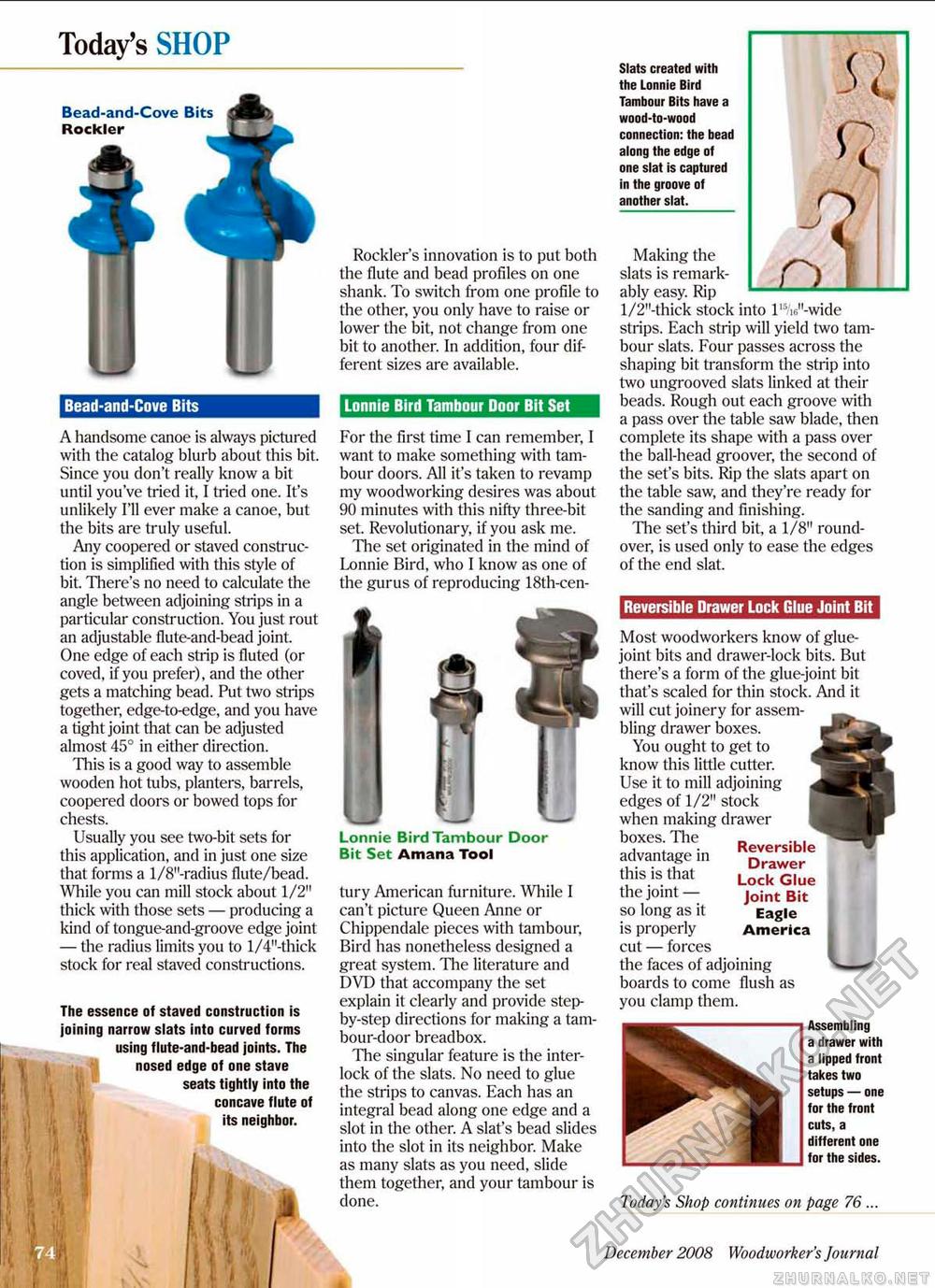Woodworker's Journal 2008-32-6, страница 75
Today's SHOP Bead-and-Cove Bits Rockier Bead-and-Cove Bits A handsome canoe is always pictured with the catalog blurb about this bit. Since you don't really know a bit until you've tried it, I tried one. It's unlikely I'll ever make a canoe, but the bits are truly useful. Any coopered or staved construction is simplified with this style of bit. There's no need to calculate the angle between adjoining strips in a particular construction. You just rout an adjustable flute-and-bead joint. One edge of each strip is fluted (or coved, ifyou prefer), and the other gets a matching bead. Put two strips together, edge-to-edge, and you have a tight joint that can be adjusted almost 45° in either direction. This is a good way to assemble wooden hot tubs, planters, barrels, coopered doors or bowed tops for chests. Usually you see two-bit sets for this application, and in just one size that forms a l/S'-radius flute/bead. While you can mill stock about 1/2" thick with those sets — producing a kind of tongue-and-groove edge joint — the radius limits you to 1/4''-thick stock for real staved constructions. The essence of staved construction is joining narrow slats into curved forms using flute-and-bead joints. The nosed edge of one stave seats tightly into the concave flute of its neighbor. Rodder's innovation is to put both the flute and bead profiles on one shank. To switch from one profile to the other, you only have to raise or lower the bit, not change from one bit to another. In addition, four different sizes are available. Lonnie Bird Tamboor Boor Bit Set For the first time I can remember, 1 want to make something with tambour doors. All it's taken to revamp my woodworking desires was about 90 minutes with this nifty three-bit set. Revolutionary, if you ask me. The set originated in the mind of Lonnie Bird, who I know as one of the gurus of reproducing 18th-cen- Lonnie Bird Tambour Door Bit Set Amana Tool tury American furniture. While I can't picture Queen Anne or Chippendale pieces with tambour. Bird has nonetheless designed a great system. The literature and DVT) that accompany the set explain it clearly and provide step-by-step directions for making a tambour-door breadbox. The singular feature is the interlock of the slats. No need to glue the strips to canvas. Each has an integral bead along one edge and a slot in the other. A slat's bead slides into the slot in its neighbor. Make as many siats as you need, slide them together, and your tambour is done. Slats created with the Lonnie Bird Tambour Bits have a wood-to-wood connection: the bead along the edge of one slat is captured in the groove of another slat. Making the slats is remarkably easy. Rip l/2"-thick stock into TV-wide strips. Each strip will yield two tambour slats. Four passes across the shaping bit transform the strip into two ungrooved slats linked at their beads. Rough out each groove? with a pass over the table saw blade, then complete its shape with a pass over the ball-head groover, the second of the set's bits. Rip the slats apart on the table saw, and they're ready lor the sanding and finishing. The set's third bit, a 1/8" round-over, is used only to ease the edges of the end slat. Reversible Drawer Lock Glue Joint Bit Most woodworkers know of glue-joint bits and drawer-lock bits. But there's a form of the glue-joint bit that's scaled for thin stock. And it will cut joinery for assembling drawer boxes. You ought to get to know this little cutter. Use it to mill adjoining edges of 1/2" stock when making drawer boxes. The advantage in this is that the joint — so long as it is properly cut — forces the faces of adjoining boards to come flush as you clamp them. Reversible Drawer Lock Glue Joint Bit Eagle America 111 Assembling a drawer with a lipped front takes two setups —one for the front cuts, a different one for the sides. Today's Shop continues on page 76 ... 75 December 2008 Woodworker's Journal |








